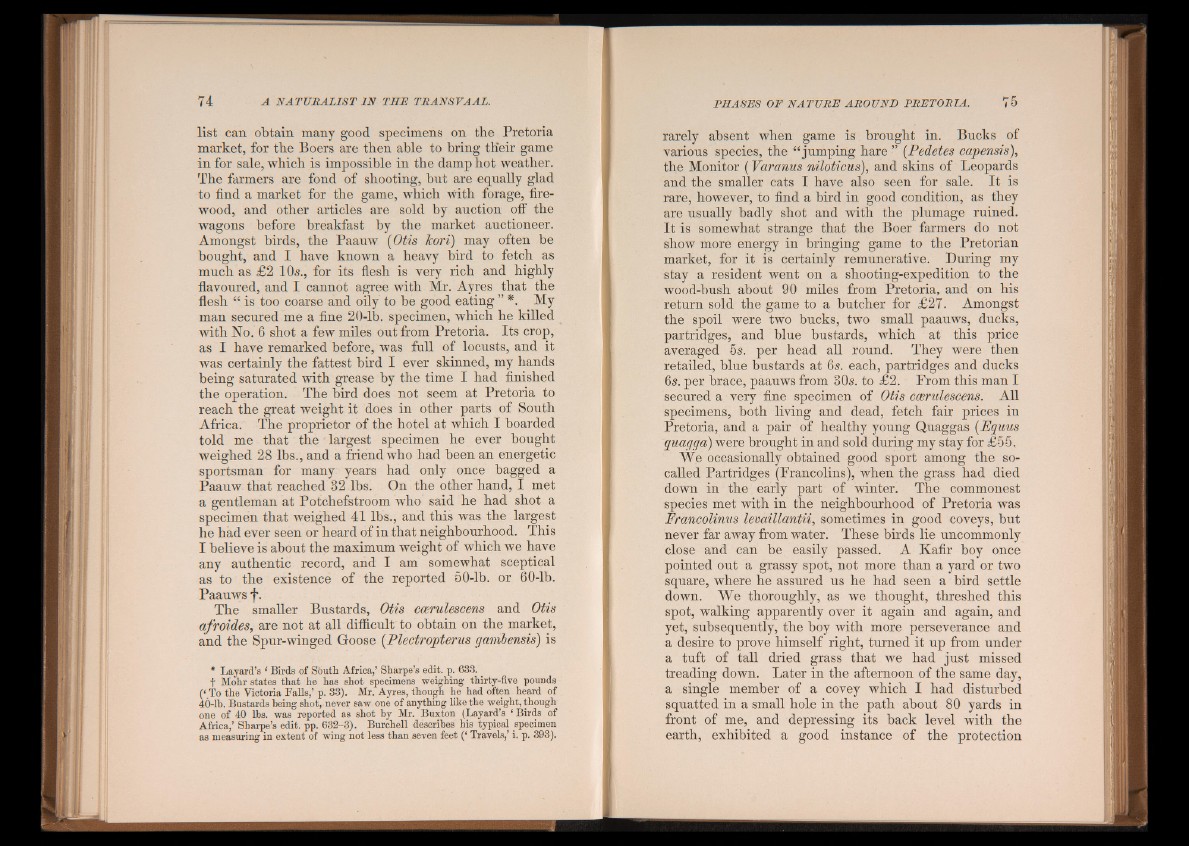
list can obtain many good specimens on the Pretoria
market, for the Boers are then able to bring th'eir game
in for sale, which is impossible in the damp hot weather.
The farmers are fond of shooting, but are equally glad
to find a market for the game, which with forage, firewood,
and other articles are sold by auction off the
wagons before breakfast by the market auctioneer.
Amongst birds, the Paauw (Otis Jcori) may often be
bought, and I have known a heavy bird to fetch as
much as £ 2 1 0 s., for its flesh is very rich and highly
flavoured, and I cannot agree with Mr. Ayres that the
flesh “ is too coarse and oily to be good eating ” *. My
man secured me a fine 2 0 -lb. specimen, which he killed
with No. 6 shot a few miles out from Pretoria. Its crop,
as I have remarked before, was full of locusts, and it
was certainly the fattest bird I ever skinned, my hands
being saturated with grease by the time I had finished
the operation. The bird does not seem at Pretoria to
reach the great weight it does in other parts of South
Africa. The proprietor of the hotel at which I boarded
told me that the largest specimen he ever bought
weighed 28 lbs., and a friend who had been an energetic
sportsman for many years had only once bagged a
Paauw that reached 32 lbs. On the other hand, I met
a gentleman at Potchefstroom who said he had shot a
specimen that weighed 41 lbs., and this was the largest
he had ever seen or heard of in that neighbourhood. This
I believe is about the maximum weight of which we have
any authentic record, and I am somewhat sceptical
as to the existence of the reported 50-lb. or 60-lb.
Paauws f .
The smaller Bustards, Otis ccerulescens and Otis
afroides, are not at all difficult to obtain on the market,
and the Spur-winged Goose (Plectropterns gambensis) is
* Layard’s ‘ Birds of South Africa,’ Sharpe’s edit. p. 633.
t Mohr states that he has shot specimens weighing thirty-five pounds
(‘ To the Victoria Falls,’ p. 33). Mr. Ayres, though he had often heard of
40-lb. Bustards being shot, never saw one of anything like the weight, though
one of 40 lhs. was reported as shot by Mr. Buxton (Layard’s * Birds of
Africa,’ Sharpe’s edit. pp. 632-3). Burchell describes his typical specimen
as measuring in extent of wing not less than seven feet (‘ Travels,’ i. p. 393).
rarely absent when game is brought in. Bucks of
various species, the “ jumping hare ” (Pedetes capensis),
the Monitor (Varanus niloticus), and skins of Leopards
and the smaller cats I have also seen for sale. It is
rare, however, to find a bird in good condition, as they
are usually badly shot and with the plumage ruined.
It is somewhat strange that the Boer farmers do not
show more energy in bringing game to the Pretorian
market, for it is certainly remunerative. During my
stay a resident went on a shooting-expedition to the
wood-bush about 90 miles from Pretoria, and on his
return sold the game to a butcher for £27. Amongst
the spoil were two bucks, two small paauws, ducks,
partridges, and blue bustards, which at this price
averaged 5s. per head all round. They were then
retailed, blue bustards at 6 s. each, partridges and ducks
6 s. per brace, paauws from 30s. to £2. From this man I
secured a very fine specimen of Otis ccerulescens. All
specimens, both living and dead, fetch fair prices in
Pretoria, and a pair of healthy young Quaggas (Equus
quagga) were brought in and sold during my stay for £55,
We occasionally obtained good sport among the so-
called Partridges (Francolins), when the grass had died
down in the early part of winter. The commonest
species met with in the neighbourhood of Pretoria was
Francolinus levaillantii, sometimes in good coveys, but
never far away from water. These birds lie uncommonly
close and can be easily passed. A Kafir boy once
pointed out a grassy spot, not more than a yard or two
square, where he assured us he had seen a bird settle
down. We thoroughly, as we thought, threshed this
spot, walking apparently over it again and again, and
yet, subsequently, the boy with more perseverance and
a desire to prove himself right, turned it up from under
a tuft of tall dried grass that we had just missed
treading down. Later in the afternoon of the same day,
a single member of a covey which I had disturbed
squatted in a small hole in the path about 80 yards in
front of me, and depressing its back level with the
earth, exhibited a good instance of the protection